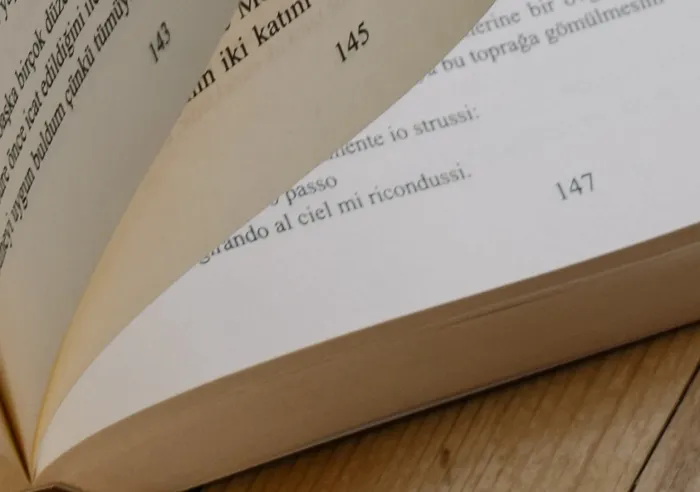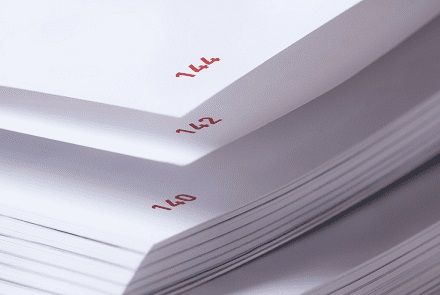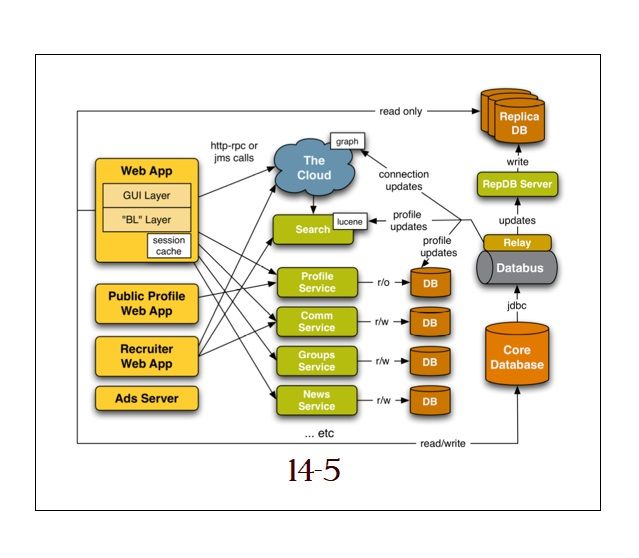Book Printing: Helpful Advice for Page Numbering

estimated reading time: 8 minutes
Book Page Numbering
Page numbers have been an important component of printed
books for centuries. This is because a logical numbering sequence provides a simple
and foolproof system for navigating to certain pages or sections within a book.
Despite the important role book page numbers play, there are
very few pagination rules that definitively govern their placement and appearance.
This means that as long as a person reading the book can navigate successfully,
just about any numbering scheme is acceptable. In other words, it's your book
and you can format the page numbers any way you prefer.
Having said that, there are some recommended "best practices"
to consider when formatting a book for print. So without further ado, below is
a list of helpful guidelines for adding page numbers to your book's page layout.

Where to position the numbers on the pages -
There are several acceptable placements for book page
numbers. As long as the page numbers are clear and consistent, the position you
choose can be guided by your personal preference. Nevertheless, there are some
practical considerations to take into account as well. These are outlined below…
Do not place page numbers too close to a trim line - first
and foremost, it is important to be aware of the book's trim size so that page
numbers do not risk being too close to the paper's edge after trimming. That will negatively affect
the appearance of the finished book. In extreme cases, page numbers could even be
partially or completely cut off during the final trim. So to be safe, it is
best to make sure the page numbers are placed no closer than .25" from any trim
line.
Avoid the inside margins - the inside margins are the page margins
closest to the book's spine. Ideally, you should avoid placing page numbers
near the inside margins. It is not only aesthetically unappealing, the reader
has to open the book very wide to see the page numbers. This makes for an
awkward and frustratingly slow process when attempting to locate specific pages.
The outside margins are a good choice - the outside margins
are the page margins closest to the open edge of the book. Placing page numbers
near the outside margins is a good choice because the book does not have to be
opened very far to view the page numbers. This allows the page numbers to be located
rather quickly. Reference books, manuals, and cookbooks are all examples of books
that benefit from having the page numbers near the outside margins. This is
because the users of these types of books usually just want to quickly pinpoint
a specific page of interest to them. By the way, page numbers placed near the
outside margins can either be placed at the top corner or the bottom corner of each
page.
Centered page numbers are also a good choice - centering page
numbers at the top or bottom of a book's pages is another good option. This offers
a balanced look that is preferred by many. It is a popular choice for novels, fiction
and non-fiction story books, and any other book where the pages are intended to
be read in chronological order from cover to cover. Other than returning to the page where a reader left off, these types of books rarely have a need to locate a specific page by its page number. So unless you have a preference otherwise,
these types of books have no real need to place the page numbers near the
outside margins for faster indexing.

Odd pages to the Right, Even pages to the Left -
Odd numbered pages (1, 3, 5, 7, etc.) should always appear
on the right hand side of an open book and even numbered pages (2, 4, 6, 8,
etc.) should always appear on the left hand side of an open book. This is a fundamental
standard for all printed books. Most people know not to violate this rule because doing so would greatly diminish the professional appearance
of the book.
Blank pages don't need to have a printed page number -
It is not uncommon for blank pages to appear within a printed book. Because
new chapters or sections should always start on a right-hand page, the opposing
left-hand page will be blank if the prior chapter or section ended on a
right-hand page.
Blank pages, regardless of where they happen to appear, are still counted as a page in the book but they do not need a printed page number. After all, a blank page contains no content, so it will never be referenced. Thus, there is no need to identify it with a page number.
Page numbering conventions for the different parts of a book -
A printed book is made up of four main parts - cover, front
matter, main content, and back matter. The cover is rarely considered part of a
book's pagination and therefore needs no page numbers. Pagination for the other
three parts is discussed below…
Front Matter - front matter refers to pages that appear before the main content. Also known as preliminary matter, the front matter is placed at the beginning of the book to provide information that helps set the stage for the main content.
The types of pages chosen to be included in the front matter varies from book to book, but pages commonly
placed within this section include the title page, copyright page, dedication, table
of contents, foreward, preface, acknowledgements, and introduction.
Because a book's front matter generally consists of only a
few distinct pages, it is not really necessary that these pages be numbered.
However, if certain sections of the front matter will be lengthy, or you generally
just prefer to number the pages, the recommended method is to use lower case
Roman numerals (i, ii, iii, iv, v, etc.) for the front matter.
That said, the table of contents does not usually receive a
page number, nor do any of the pages preceding the table of contents require a page number. But
again, this is a matter of personal preference.
Main Content - also known as the body of the book, this is
where the bulk of the book's content appears. The main content is numbered
using the common Arabic numbers of 1, 2, 3, 4, 5, etc.
The first page of the main content will be page number 1.
The first page, and the first page of all subsequent chapters or sections
within the book, should be placed so they appear on the right hand side of the open book. The right side of an open book is known as "Recto" and all odd
numbered pages should appear on the right hand side.
The second page of the main content will be page number 2. This
second page will appear on the left hand side of the open book, as will the
second page of all subsequent chapters or sections throughout the book. The
left side of an open book is known as "Verso" and all even numbered pages
should appear on the left hand side.
If a chapter or section ends on the right hand side of the
book, the very next page should be left blank. This will ensure the next
chapter or section begins on the right hand side. This blank page will be
counted in the book's main pagination sequence but it does not need to have a printed
page number.
For example, let's say Chapter 5 ends on the right side of
the book at page 67. Because Chapter 6 should begin on the right side of the
book, the next page after page 67 will be on the left side of the book and it
should be a blank page. Even though this blank page will be counted as page 68
in the book's page numbering sequence, it does not need to have a printed
number. The next printed page number will be 69, which appears opposite the
blank page and will be the first page of Chapter 6.
Back Matter - also known as end matter, back matter refers to pages that appear after the main content. Back matter includes any supplemental documentation or reference material needed to support the main content.
Just like front matter, the types of pages chosen to be part of the back matter will vary from book to book. Examples of content typically placed within the back matter includes the appendix, glossary, bibliography/references,
index, and author biography.
Because the back matter will be referenced in the table of
contents, it will need to have page numbers. The page numbering sequence of
Arabic numerals used for the main content should simply continue on through the
back matter.

Special considerations for content that requires periodic updates -
Some types of books - particularly operational,
instructional, and technical manuals - require periodic updates to remain
current. Instead of using a traditional numbering system that runs
chronologically throughout the entire book, these books are better served by
assigning numbers to the various sections and then appending page numbers that
start over at "1" for each section.
For example, the page numbers in section 1 could be 1-1,
1-2, 1-3, etc. The page numbers in section 2 could be 2-1, 2-2, 2-3. The page
numbers in section 3 could be 3-1, 3-2, 3-3 and so on.
The benefit of this page numbering method is that a section
or part of a section can be replaced without affecting the page numbering order
of any other section. Of course, this method works best for loose leaf pages secured
with a binding method that allows for sheets to be easily added or removed,
such as a ringed binder.
Even if the book is printed with a permanent binding style that
doesn't allow page changes, this page numbering method is still beneficial because the artwork file can be easily updated for the next book printing without having to change the page numbers throughout the entire book.
Do you have an upcoming book project and need some help?
Whether you have a need for book printing or any other type
of printing project, Color Vision is always ready to help! Just give
us a call at 800-543-6299 to discuss your needs.
Or, use our Quote Request form to
submit your specifications and we will email you a quote. As always, we look
forward to assisting you!
Related Article: How to Provide an Accurate Page Count
Related Articles

Booklet Catalogs: Why is this Catalog Format so Popular?
Read This Article

Creating a Comic Book? Here’s some Advice from a Printer
Read This Article

Perfect Binding vs PUR Binding: What is the Difference?
Read This Article

Perfect Bound Book Printing: Tips for getting the Best Value
Read This Article